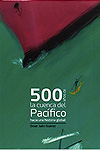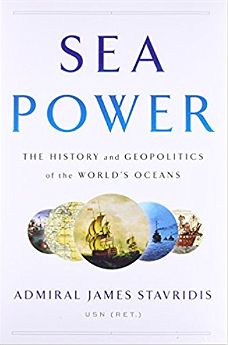Ruta de navegación
Menú de navegación
Blogs
Entries with label pacific .
[Omar Jaén Suárez, 500 years of the Pacific Basin. Towards a global history. Ediciones Doce Calles, Aranjuez 2016, 637 pages]
review / Emili J. Blasco
In just thirty years, between Columbus' arrival in America in 1492 and Elcano's return to Cadiz after his round-the-world voyage in 1522, Spain added to its domain not only a new continent, but also a new ocean. We all know about Spain's Atlantic dimension, but we often disregard its peaceful dimension. During the sixteenth and early seventeenth centuries, the Pacific Ocean was primarily under Spanish dominion. Spain was the European power present for the longest time and with the greatest weight in the entire basin of what began to be called the South Sea. Spain was the first navy that regularly patrolled its waters - the Armada del Sur, based in El Callao, Peru - and Spain was the first trade route that periodically crossed it from side to side - the Manila galleon, between the Philippines and Mexico.
 |
In "500 years of the Pacific Basin. Toward a global history", Panamanian diplomat and historian Omar Jaén Suárez does not limit himself to documenting that Spanish and then Hispanic presence in a vast space -one third of the Earth's sphere and half of its waters- whose eastern margin is the coast of Spanish America. As degree scroll indicates, his is a global history. But to approach the last half millennium means that it starts from the fact that the Spanish conquered the Pacific Ocean and that this is a global history. finding of the Pacific by the Spaniards and that determines the approach of the narration.
If Anglo-Saxon historiography would have perhaps used another prism, in this book the accent is placed on the development of the entire Pacific account from the arrival of the first Europeans, with Nuñez de Balboa at the head. Without forgetting the colonizing facts of other powers, the author details aspects that the Spanish do forget, such as the permanent base that Spain had in Formosa (today Taiwan), the attempts of the Crown to keep Tahiti or the voyages through Alaska in search of a sea passage to the north of America, which had as a logistic point the island of Quadra and Vancouver, the great Canadian city today known only by the second part of that name (in fact, Spain neglected to populate Oregon, more interested in the Philippines and trade with the Moluccas): quite a pioneering "turn to Asia").
Being from Panama gives Omar Jaén, who has also lived in Spain, a special sensitivity for his subject study. The Panamanian isthmus has always been the key to the South Sea for the Old World; with the construction of the canal, Panama is also a transit point between East and West.
The careful edition of this work adds an indisputable value. Almost eight hundred maps, graphs, engravings and photographs make it especially visual. The quantity of illustrations, many in full color, and the good weight of the paper make the volume thicker, in a printing that constitutes a luxury for anyone interested in the Pacific. Ediciones Doce Calles has taken great care with this first degree scroll of a new collection, Pictura Mundi, dedicated to celebrating travels, explorations and geographical discoveries.
[Admiral James Stavridis, Sea Power. The History and Geopolitics of the World's Oceans. Penguin Press. New York City, 2017. 363 pages]
review / Iñigo Bronte Barea [English version].
In the era of globalisation and its communication society, where everything is closer and distances seem to fade away, the body of water between continents has not lost the strategic value it has always had. Historically, the seas have been both a channel for human development and instruments of geopolitical domination. It is no coincidence that the great world powers of the last 200 years have themselves been great naval powers. The dispute over maritime space is still going on today and there is nothing to suggest that the geopolitics of the seas will cease to be crucial in the future.
These principles on the importance of maritime powers have changed little since they were set out in the late 19th century by Alfred T. Mahan. Today, Sea Power. The History and Geopolitics of the World's Oceans, by Admiral James G. Stavridis, who retired in 2013 after leading the US Southern Command, the US European Command and the supreme command of NATO.
The book is the fruit of Mahan's early reading and an extensive degree program of nearly four decades on the seas and oceans with the US Navy. At the beginning of each explanation of the different sea spaces, Stavridis recounts his brief experience in that sea or ocean, then continues with the history, and the development they have had, until arriving at their current context. Finally, there is a projection of the near future of the world from the perspective of marine geopolitics.
Pacific: China's emergence
Admiral J.G. Stavridis begins his voyage in the Pacific Ocean, which he categorises as "the mother of all oceans" because of its immensity, since it alone is larger than the entire land surface of the planet combined. Another remarkable point is that in its vastness there is no considerable landmass, although there are islands all over the world subject, with very diverse cultures. This is why the sea dominates the geography of the Pacific like nowhere else on the planet.
 |
The great dominator of this marine space is Australia, which is very much aware of what might happen politically in the island archipelagos in its vicinity. It was Europeans, however, who explored the Pacific well (Magellan was the first, around 1500) and tried to connect it with their world in a way that was not merely transitory and commercial, but stable and lasting.
The United States began its presence in the Pacific with the acquisition of California (1840), but it was not until the annexation of Hawaii (1898) that the huge country was definitively catapulted into the Pacific. The first time this ocean emerged as a total war zone was in 1941 when Pearl Harbour was massacred by the Japanese.
With the return of peace, the Japanese revival and the emergence of China, Taiwan, Korea, Singapore and Hong Kong caused trans-Pacific trade to overtake the Atlantic for the first time in the 1980s, and this trend is still continuing. This is because the Pacific region contains the world's major powers on its shores.
degree program At area geopolitics a major arms race is taking place in the Pacific, with North Korea as a major focus of global tension and uncertainty.
Atlantic: from the Panama Canal to NATO
As for the Atlantic Ocean, Stavridis refers to it as the cradle of civilisation, since the Mediterranean is included among its territories, and even more so if we consider it as the nexus between the peoples of the Americas and Africa and Europe. It has two great seas of great historical importance, the Caribbean and the Mediterranean.
Undoubtedly the historical figure of this ocean is Christopher Columbus, since his arrival in America (Bahamas 1492) initiated a new historical period that ended with practically the entire American continent being colonised by the European powers in the following centuries. While Portugal and Spain concentrated on the Caribbean and South America, the British and the French concentrated on North America.
During the First World War, the Atlantic became an essential transit zone for the war development as the United States transported troops, war materials and goods to Europe during the conflict. It was here that the idea of an Atlantic community began to take shape, leading to the creation of NATO.
As for the Caribbean, the author sees it as a region that is rooted in the past. Its colonisation was characterised by the arrival of slaves to exploit the region's natural resources for purposes of economic interest to the Spanish. In turn, this process was characterised by the desire to convert the indigenous population to Christianity.
The Panama Canal is a driving force for the region's Economics , but Central America is also sailing along the coasts of the countries with the highest violence fees on the planet. Admiral Stavridis sees the Caribbean coast as a kind of Wild West, which in some places has evolved little since the days of pirates, and where drug cartels now operate with impunity.
Since the 1820s, with the Monroe Doctrine, the United States carried out a series of interventions through its navy to bolster regional stability and keep Europeans out of places such as Haiti, the Dominican Republic and Central America. In the 20th century, politics was dominated by caudillos, and soon communism and the Cold War came with them to the Caribbean, with Cuba as ground zero.
Indian Ocean and Arctic: from unknown to risky
The Indian Ocean has less history and geopolitics than the other two great oceans. Despite this, its tributary seas have gained geopolitical importance in the post-World War II era with the rise of global shipping and the export of oil from the Gulf region. The Indian Ocean today could be seen as a region for wielding smart power rather than hard power. While the slave trade and piracy have dwindled almost everywhere, they are still present in parts of the Indian Ocean. It is a region where countries around the world could work together to combat these common problems.
The history of the Indian Ocean does not inspire confidence about the potential for peaceful governance in the years to come. An important core topic to unlock the region's potential would be to resolve the existing conflicts between India and Pakistan (a conflict with the risk of nuclear weapons) and the Shia-Sunni divide in the Persian Gulf, issues that make it a very volatile region. Due to tensions in the Gulf countries, the region is today a kind of cold war between the Sunnis, led by Saudi Arabia, and the Shiites, led by Iran, and between these two sides, the United States, with its Fifth Fleet, is at the centre.
Finally, the Arctic is currently an unknown quantity. Stavridis sees it as both a promise and a danger. Over the centuries, all oceans and seas have been the site of epic battles and discoveries, but there is one exception: the Arctic Ocean.
It seems clear that this exceptionality is coming to an end. The Arctic is an emerging maritime frontier with increasing human activity, rapidly melting ice shelves and significant hydrocarbon resources coming within reach. However, there are major risks that will dangerously condition the exploitation of this region, such as weather conditions, unclear governance due to the confluence of five bordering countries (Russia, Norway, Canada, the United States and Denmark), and geopolitical competition between NATO and Russia, whose relations have deteriorated in recent years.
